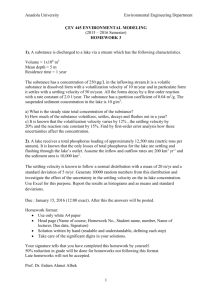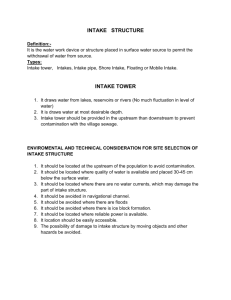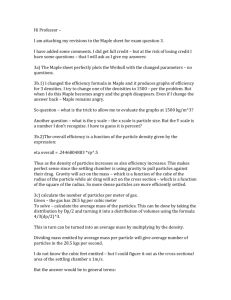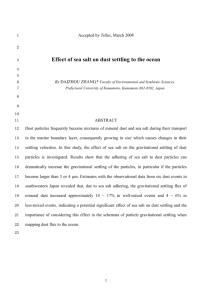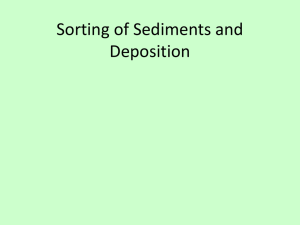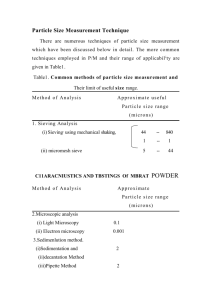Sedimentation CHAPTER: 10 Sedimentation
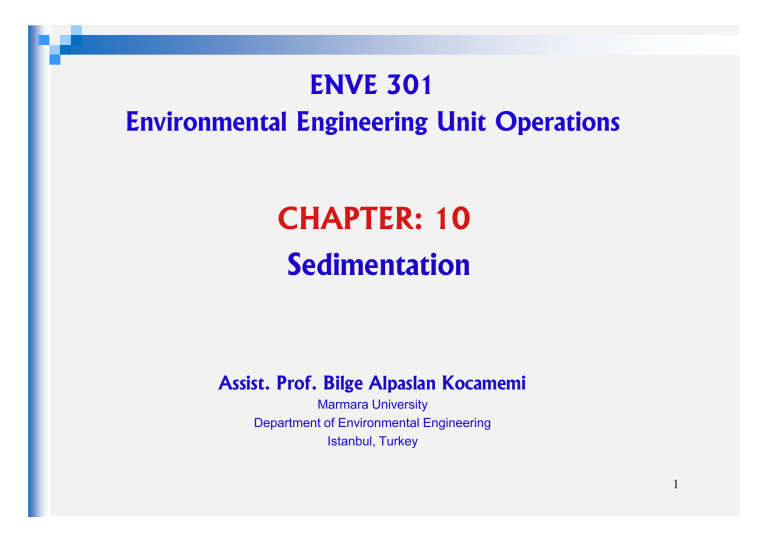
ENVE 301
Environmental Engineering Unit Operations
CHAPTER: 10
Assist. Prof. Bilge Alpaslan Kocamemi
Marmara University
Department of Environmental Engineering
Istanbul, Turkey
1
Sedimentation
seperation of unstable and destabilized suspended solids from a suspension by the force of gravity
Applications in Water Treatment:
1.
settling of coagulated and flocculated waters prior to filtration
2.
settling of coagulated and flocculated waters in a softening plant
3.
settling of treated waters in an iron and manganese removal plant
Applications in Wastewater Treatment:
1.
grit removal
2.
suspended solids removal in primary clarifier
3.
biological floc removal in activated sludge
2
Sedimentation
Settling of particles from suspension depends on:
Characteristics of the Particles
PARTICLES particles whose size, shape and specific gravity do not change with time.
PARTICLES particles whose surface properties are such that they aggregate upon contact
Thus, changing in size, shape, and perhaps specific gravity with each contact
Concentration of Particles in Suspension
DILUTE suspensions in which the conc. of particles is not sufficient to cause significant displacement of water as they settle or in which the particles will not be close enough for velocity field interference to occur
SUSPENSIONS suspensions in which the conc. of particles is too great to meet the conditions mentioned for dilute suspensions
3
TYPE 1
(discrete particle settling)
•
•
•
TYPE 2
•
•
(flocculant settling) settling of discrete particles in dilute suspensions particles have no tendency to flocculate they settle as individual entities and there is no significant interaction with neighboring particles settling of flocculant particles in dilute suspensions as particle settle and coalesce with other particles, the sizes of particles and their settling velocity increases
Example: removal of grit and sand in wastewater treatment
Examples:
• removal of SS in primary sedimentation
• tanks of WWTP settling of chemically
TYPE 3
(hindered settling) or
(zone settling)
TYPE 4
(compression settling)
•
•
• settling of intermediate concentration of flocculant particles particles are so close together that interparticle forces are able to hold them in fixed positions relative to each other and the mass of particles settles as a zone at a constant velocity settling of particles that are of such a high concentration that the particles touch each other and settling can occur only by compression which takes place from the weight of particles
Example: biological floc removal in secondary settling basins of
WWTP
•
•
Examples: occurs in the bottom of deep secondary clarifiers in sludge thickening facilities 4
Type 1 – Discrete Settling
If a particle is suspended in water , it initially has 2 forces acting upon it.
1. The forces of gravity f g
= ρ p g
∀ p
2. The buoyant force quantified by Archimedes.
f b
= ρ w g
∀ p
Once motion has been initiated, a third force is created due to viscous friction
1. Drag force f
D
=
C
D
A p
ρ w
υ s
2
2
ρ p
= density of particle
∀ p
ρ
∀ p
= volume of particle
=
= density volume of water of particle
C
D
A p
=
= drag coeff.
cross sectional area of particle perpendicu lar to the direction of movement
ρ w
υ s
= density
= settling of water velocity of particle
5
Force balance for a discrete particle that is settling m p d
ϑ s dt
=
F
G
−
F
B
−
F
D
Downward acceleration of particle
After an initial transient period, the acceleration velocity becomes constant.
d
υ s dt becomes zero and the settling
0 m p
= d
ϑ s dt
=
0
=
F
G
−
F
B
−
F
D
(
ρ p g
∀ p
) (
ρ w g
∀ p
)
−
C
D
A p
ρ w
ϑ s
2
2
6
0
= g
∀ p
(
ρ p
− ρ w
)
−
C
D
A p
ρ w
ϑ s
2
2
g
∀ p
(
ρ p
− ρ w
)
=
C
D
A p
ρ w
ϑ s
2
2
ϑ s
=
2 g
(
ρ p
− ρ w
)
∀ p
SETTLING VELOCITY OF
DISCRETE PARTICLE IN ANY SHAPE
For spherical particle;
∀ p
A
=
=
4
3
π r
3
π r
2
∀ p
A p
=
4
3
π
π r r
2
3
=
=
4 d
3 2
4
3 r
ϑ
s
=
2 g
(
ρ
p
− ρ
w
)
4
C
D
ρ
w d
3 2
ϑ
s
=
3
4
(
ρ
p
− ρ
w
) gd
C
D
ρ
w
SETTLING VELOCITY OF
SPHERICAL DICRETE PARTICLE
( Eqn 2)
Newton’s drag coefficient (C
D
) is a function of:
• Flow regime around the particle
• Particle shape
R e
<
1
1
<
R e
<
10
4
R e
R e
R e
>
10
4
=
=
ϑ s
ν
D
φϑ
ν s
D
(for
ν =
ρ
µ w
( kinetic nonspheric al
visc.) particles)
8
Drag coefficient (C o
) for spheres:
C
D
=
24
R e
+
3
R e
+
0 .
34
For laminar flow
R e
<
1
C
D
=
24
R e
+
C
D
=
24
R e negligible
3
R e
+
0 .
34 where
R e
=
ν s =
C
D
=
24
ϑ s
µ d
ρ w
For laminar flow
ϑ s
= g
18
µ
(
ρ p
− ρ w
) d
2 Settling velocity of spherical discrete particles under laminar flow conditions (STOKE’S LAW) ( Eqn. 3) s
µ
9
For turbulent flow R e
>
10
4
C
D
=
0 .
34
−
0 .
4
Substitute into Eqn.2
commonly used
ϑ s
=
10
3 g
(
ρ p
− ρ w
) d
ρ w
Settling velocity of spherical discrete particles under turbulent flow conditions
10
Example 1: Find the terminal settling velocity of a spherical discrete particle with diameter 0,5 mm and specific gravity of 2.65 settling through water at 20 0 C
ρ w
=
998 .
2 kg / m
3
µ =
1 .
002 .
10
−
3
Ns / m
2
11
Critical Settling Velocity & Overflowrate
→ Particles move horizontally with the fluid (all particles have the same horizontal velocity)
→ Particles move vertically with terminal settling velocity
(different for particles with different size, shape and density)
All particles with V s
>
V c
Particle with
V
< s
V c will be completely settled.
will be removed in the ratio V p
/ V c
12
V c
= critical velocity
= tank depth detention time
= tan k depth volume / flowrate
=
( depth depth
.
area
)
/ flowrate
= flowrate area
=
Q
A
SURFACE LOADING or
OVERFLOW RATE
(Settling velocity of the slowest-settling particles that are 100% removed)
In a typical suspension of discrete particles a large variation in particle size
To determine the overall removal for a given design settling velocity (or overflowrate) the settling velocity distribution for the suspension must be determined
Experimental analysis use of a settling column use of sieve analysis and hydrometer tests.
13
14
Batch Settling Column Test for Type 1 Settling
Depth of column is not a factor in the analysis ( about 2 m)
Diameter of column about 200 mm
Procedure:
Z
0
Sampling port
1.
Height of the port is measured
4.
5.
2.
Suspension to be tested is placed in the column
Mixed completely to ensure uniform distribution of particles
3.
At time=0, a portion of the sample is removed from the port
TSS analysis is carried out in order to determine the initial TSS concentration
The suspension is allowed to settle
6.
Intermittent samples are removed at appropriate time intervals
For each sample withdrawn,
TSS analysis must be performed in order to determine the fraction remaining in suspension at each time interval
Settling velocity at each time interval (V’=H/t’; V’’=H/t’’; V’’’=H /t’’’….) fraction with settling velocity less than stated vs terminal setling velocity 15
0,7
0,6
0,5
0,4
-
Xc
0,3
0,2
0,1
0
0 0,05 0,1 0,15 0,2 0,25 Vc 0,3 0,35 0,4 settling velocity, m/min
0,45 0,5 0,55 0,6 0,65
Fraction removed
=
( 1
−
X
C
)
+
∫ xc
V
P
0
V
C dx
Fraction particles with velocity greater than Vc
Fraction particles with removed with velocity less than Vc
16
Sieve Analysis for Type 1 Settling
1. Particle Size vs Weight fraction greater than size (%) are determined
2. Settling velocity for each particle size is calculated setling velocity) is drawn
Fraction removed
=
( 1
−
X
C
)
+ ∫
V
P
V
C dx
Fraction particles with velocity greater than Vc
Fraction particles with removed with velocity less than Vc
17
Type 2 – Flocculent Settling
(settling of flocculent particles in dilute suspension)
Chemical precipitates formed in coagulation and other destabilization processes tend to agglomerate while settling as a result of interparticle collisions
As a result;
→ their sizes change continually (increases)
→ their shapes change continually
→ their specific gravity change
(as a result of entrapment of water in interstitial spaces)
18
Example 2:
Particle Type Weight Fraction W i
Settling Velocity, V i
1 0.1
0.2 m/sec
2
3
4
0.3
0.2
0.4
0.1 m/sec
0.3 m/sec
0.15 m/sec
If V c
=0.16 m/sec for a given settling tank, what is the % of all solids removed?
Example 3: A settling analysis is run on a Type 1 suspension in a laboratory column with a port 1.8m below the suspension surface. The data obtained are shown below.
Time (min)
0
3
5
TSS (conc, mg/L)
220
116
98
20
40
60
35
10
2
What will be the theoretical removal efficiency in a settling basin for an overflow of 432 m 2 /m.day?
Solution of Example 2 :
Time (min) TSS (conc, mg/L)
0
3
5
200
116
98
20
40
60
35
10
2
Mass Fraction
Remaning
-
0.58
0.49
0.18
0.05
0.01
Vs (m/min)
-
1.8/3=0.6
1.8/5=0.36
1.8/20=0.09
1.8/40=0.045
1.8/60=0.03
Overflowrate=V c
=
432 m 2 m .
.
d
1 d 1 hr
0 .
3 m / min
X c
=0.46
Total removal =
(
1
−
X c
)
+
1
V c
Xc
0
∫
Vdx
=
0 .
54
+
1
0 .
3
(
0 .
0143
+
0 .
0158
+
0 .
01266
+
0 .
0077
+
0 .
0044
)
=
0 .
54
+
0 .
05486
0 .
3
=
=
0 .
72
72 %
0.06
0.1
0.1
0.1
0.1
0.2388
0.158
0.1266
0.077
0.044
0.0143
0.0158
0.01266
0.0077
0.0044
Example 4: A settling basin is designed to have a surface overflowrate of 32.6m/d.
Determine the overall removal obtained for a suspension with the size distribution given in the table below. The specific gravity of the particles is 1.2 and water temperature is 20 o C .
µ
-3
ρ
Particle Size , mm
0.1
Weight Fraction Greater Than Size , %
10
0.07
0.06
0.04
0.02
0.01
40
70
93
99
100
Solution of Example 3:
0.04
X c
=0.267
Total removal
=
(
1
−
X c
)
+
1
V c
Xc
0
∫
Vdx
=
0 .
733
+
1
0 .
37
(
0 .
00945
+
0 .
0128
+
0 .
0116
+
0 .
01
+
0 .
008
+
0 .
006
+
0 .
0026
)
=
=
0
89
.
89
% dx
0.027
0.04
0.04
0.04
0.04
V
0.35
0.32
0.29
0.25
0.20
0.065
V.dx
0.00945
0.0128
0.0116
0.01
0.008
0.0026
24
Type 2 – Flocculent Settling
(settling of flocculent particles in dilute suspension)
Chemical precipitates formed in coagulation and other destabilization processes tend to agglomerate while settling as a result of interparticle collisions
→ sizes change
→ shape change
→ specific gravity change (as a result of entrapment of water in interstitial spaces)
25
Type 2 – Flocculent Settling (Continue)
As their size increases, they settle at a faster velocity STOKE’s law not applicable impossible to develop a general formula for determining settling velocities of flocculant particles.
To determine the settling characteristics suspension of flocculant particles batch settling column test must be performed
26
Batch Settling Column Test For Type 2 Settling
Min . Diameter of column about 150 - 200 mm
(to minimize sidewall effects) Z
0
Sampling port
Sampling port
Sampling port
Sampling port
Height of column depth of the proposed tank
Sampling ports are provided at equal intervals in height
Procedure:
1.
Suspension to be tested is placed in the column
Mixed completely to ensure uniform distribution of particles
3.
At time=0, a portion of the sample is in order to determine the initial TSS concentration
4.
The suspension is allowed to settle
5.
At periodic time intervals, samples are removed through the ports located in different heights.
For each sample withdrawn at each depth and for each time ,
TSS analysis must be performed in order to determine the fraction remaining in suspension at each time interval
6.
Percent removals
X ij
= mass fraction removed (at i th depth at j th time interval) = ( 1- C ij
/C
0
) x 100
7. Percent removal lines ( isoremoval lines ) are drawn by interpolation.
28
29
To find the total removal at any chosen time;
% removal of completely removed fraction
% removal of partially removed fraction
Initially; a vertical line from the chosen time is projected upward.
% removal of completely removed fraction
% read at chosen time % of particles that are completely removed.
% read at chosen time % of particles having Average
Design settling ≥ settling velocity velocity
30
To determine the % removal of partially removed fractions particles having settling velocity <design settling velocity will be removed in the ratio of average settling velocity of fraction
(ave depth reached in chosen time/chosen time) design settling velocity (total depth /chosen time)
Median lines are drawn between the percent removal lines
Ave. depth reached read from the intersection point of vertical line and drawn median line
% partially removed= average depth reached by fraction total depth x Fraction
31
Example 5 ( Type 2 Settling):
A column analysis of a flocculating suspension is run in the apparatus shown below. The initial solids concentration is 250 mg/L. The resulting matrix is shown below. What will be the overall removal efficiency of a settling basin which is 3 m deep with a detention time of 1 h and 45 min.
Depth m
1
1.5
2
2.5
3
30
180
203
213
220
225
60
Time of sampling, min
90 120 150
125
150
168
180
188
93
118
135
145
155
65
93
110
123
133
55
70
90
103
113
180
43
58
70
80
95
32
SOLUTION:
Removal at each depth and time: X ij
=
1
−
C ij
C o
100
Depth m
0.5
1
1.5
2
2.5
3
19
15
12
10
30
47
28
40
33
28
25
60
67
50
Time of sampling, min
53
46
42
38
90
80
63
120
85
74
63
56
51
47
150
88
78
72
64
59
55
180
91
83
77
72
68
62
Plot isoremoval lines by interpolation
33
34
Detention time = 1hr 45 min =105min
Draw a vertical line from 105 min
% removal of completely removed fraction at t=105min = 43%
(from graph, by interpolation)
% removal of partially removed fraction : bw 43-50% fraction 7%, ave. depth reached by fraction 2.6
bw 50-60% fraction 10%, ave. depth reached by fraction 1.8
bw 60-70% fraction 10%, ave. depth reached by fraction 1.2
% removal
=
3
7 %
=
6 .
06 %
% removal
=
1.8
3
10 %
=
6 %
% removal
=
1.8
10 %
3
=
6 % bw 70-80% fraction 10%, ave. depth reached by fraction 0.8
% removal
=
0.8
3
10 %
=
2 .
66 % bw 80-90% fraction 10%, ave. depth reached by fraction 0.45
% removal
=
0.45
10 %
3
=
1 .
5 % bw 90-100% fraction 10%, ave. depth reached by fraction 0.15
removal
=
0.15
10 %
3
=
0 .
5 %
= 20.72%
Total removal at time=105min = completely removed % + partially removed %
= 43 % + 20.72 %
= 63.72 %
NOTE : In applying isoremoval curves to design a tank, scale – up factors of
0.65 the overflowrate
1.75 for the detention time are used to compensate for the side wall effects of the batch settling column.
36
37
38
39
40
41
Example 6:
A city must treat about 15000 m 3 /day of water. Flocculation particles are produced by coagulation and a column analysis indicates that an overflowrate of 20 m/day will produce satisfactory removal at a depth of
3.5m.Determine the size of b) the required circular settling tanks
42
EXAMPLE 6 :
Design circular primary sedimentation tanks for a domestic wastewater treatment plant having Q avg
=70000m 3 /d and Q peak
= 105000m 3 /day.
43
Sedimentation Basin Design
Settling basins rectangular (horizontal view) square(occasionally used) circular (radial flow) in plan view
A single rectangular basin will cost more than a circular basin of the same size
However; if numerous tanks are required rectangular tanks can be constructed with common walls and be the most economical.
NOTE: a minimum of two basins should be provided in order to be able to inspect, repair ,
44 periodically clean and maintain one basin at a time while the other basin is in operation.
Sedimentation tanks can be divided into 4 different functional zones;
1.
Inlet zone
2.
Settling zone
3.
Sludge zone
4.
Outlet zone
45
Inlet Structures • should dissimate influent energy
• distribute the flow
• mitigate density currents
• minimize sludge blanket disturbance are designed to uniformly distrubute the influent suspension over the cross section of the settling zone.
For Rectangular Basins full width inlet channels effective spreading of flow introduce a vertical velocity component into sludge happen that may resuspend sludge.
inlet channels with submerged orifices
For sedimentation tank followed by flocculation width of flocculation basin – width of settling tank
(depths are different)
Depth of inlet channel = depth of flocculator basin 46
Pipe connection between flocculation unit & sedimentation
Low velocity in pipe settling of floc
High velocity in pipe breakage of floc
Permissible flow velocity to maintain floc suspension 0.15 – 0.6 m/sec
If sedimentation tank does not adjoin a flocculator inlet channels with submerged orifices do not extend down the full depth of the tank
47
48
Influent
Orifices
Effluent
49
50
51
Inlet Structures (continue)
For circular tanks circular tanks radial flow to achieve a radial flow patterninfluent is introduced in the center of the tank or around the periphery of the tank
Central feed water enters a circular well designed to distribute the flow equally in all directions
D of feed well = 15-20 % of tank diameter
Depth= 1- 2.5m
Velocity through the orificies on feed well
0.075- 0.15 m/sec entrance pipe suspended from bridge OR encased in concrete beneath the tank floor 52
For peripheral feed (not as uniform as central feed) orifice channel around periphery of the tank from the channel the flow discharges through the orifices into sedimentation tank
53
54
55
56
57
58
59
60
61
62
63
64
65
Settling Zone
It depends on the following desing parameters:
Settling characteristics of the suspended matter
Surface loading (over flowrate)
Width / length ratio OR diameter
Detention time
66
Sludge Zone
Rectangular tanks the bottom is slightly sloped to facilitate sludge scraping a pair of endless conveyor chains bridge – type mechanism continously pulls the settled material into a sludge hopper where it is pumped out periodically.
Motion of scraper momentarily resuspend lighter particles a few cm above the scraper blades
Excessive horizontal velocity
( for the case of rectangular basins) move these materials towards outlet zone.
To prevent this, horizontal velocity < 9 m/hr for light flocculant suspensions
≈ 36 m/hr for heavier discrete suspensions
67
Bridge type mechanism travels up and down the tank one or more scraper blades are suspended from the bridge
68
69
70
71
72
73
Circular tanks
The bottom of the tank is sloped to form an inverted cone and the sludge is scraped to a relatively small hopper located near the center of the tank
Velocity or scraper important
Very high velocty resuspension of settled particles (<5mm/sn)
Travelling bridge with sludge suction headers and pumps not very good
74
75
76
Outlet Zone weir channels are used
Checked by weir loading (m 3 /m.day)
Q
L
Large weir loading resuspension of particles settled near to effluent launders
Effluent weirs placed as far from the inlet as possible
77
to increase weir length (i.e to decrease weir loading) double-sided weirs can be used
Typical weirs 90 o V notch metal plates bolted onto the effluent collection through
78
May be placed at the opposite and of the rectangular basins through the entire width of tank through the length of the tank if the weir loading causes the required weir length to be greater than tank width the around the perimeter of center – feed circular tanks at the center of peripheral feed circular tanks
79
80
81
Influent
Orifices
Effluent
82
83
84
85
86
87
